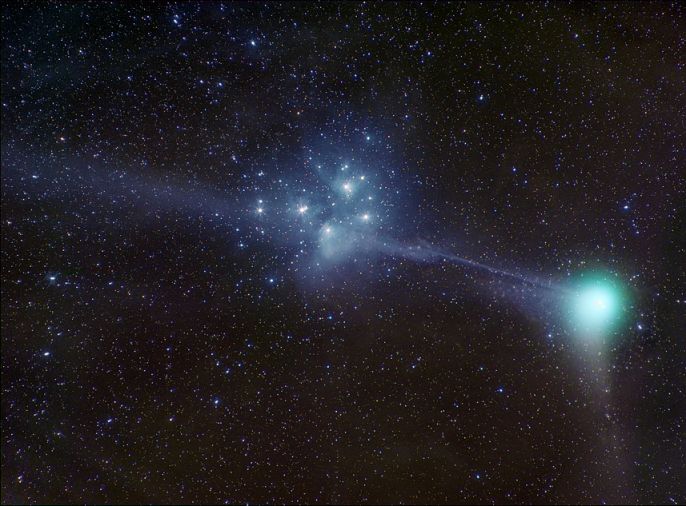Credit & Copyright: Stefan Seip
Explanation:
Sweeping northward in planet Earth's sky,
comet Machholz
extended its long ion tail with the
Pleiades star cluster
in the background on January 7th.
This stunning view,
recorded with a telephoto lens in
skies over Oberjoch, Bavaria, Germany, emphasizes faint,
complex tail
structures and the scene's lovely blue
and green colors.
Merging with the blue dust-reflected starlight of the Pleiades,
colors in the comet's
ion tail and greenish coma are
produced as gas molecules
fluoresce in sunlight.
Reflecting the sunlight, dust from
comet Machholz trails
along the comet's
orbit
and forms the whitish tail jutting
down and toward the right.
While the visible
coma
spans about 500,000 kilometers,
the nucleus of the comet, likely only a few kilometers
across, lies hidden within.
Comet tails can extend
many millions of kilometers
from the nucleus, but appear substantially shortened
because of perspective.
1999 2000 2001 2002 2003 2004 2005 2006 2007 2008 2009 2010 2011 2012 2013 2014 2015 2016 2017 2018 2019 2020 2021 2022 2023 2024 2025 |
Yanvar' Fevral' Mart Aprel' Mai Iyun' Iyul' Avgust Sentyabr' Oktyabr' Noyabr' Dekabr' |
NASA Web Site Statements, Warnings, and Disclaimers
NASA Official: Jay Norris. Specific rights apply.
A service of: LHEA at NASA / GSFC
& Michigan Tech. U.
|
Publikacii s klyuchevymi slovami:
Comet Machholz - pleiades - comet - star cluster - comet tail - M 45 - Pleyady - Rasseyannoe skoplenie - kometa Machholc
Publikacii so slovami: Comet Machholz - pleiades - comet - star cluster - comet tail - M 45 - Pleyady - Rasseyannoe skoplenie - kometa Machholc | |
Sm. takzhe:
Vse publikacii na tu zhe temu >> | |
